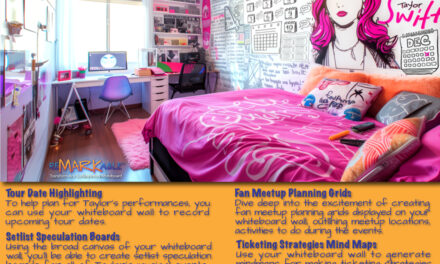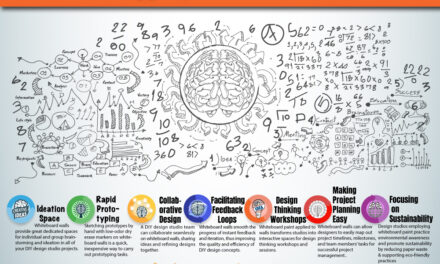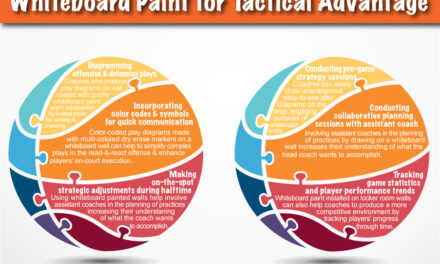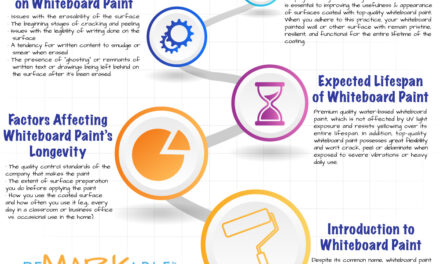
How to Improve the Readability of Text on Your Dry Erase Painted Wall
Although premium dry erase painted walls are designed to always allow for highly readable writing due to their large size and bright smooth surface, it’s essential to follow certain practices and maintain certain conditions in the surroundings to ensure that your wall functions at its best and the content on the surface can be easily read. The fact of the matter is that not everyone has the ability to produce beautiful handwriting, and even those who do may struggle to transfer this skill to writing on a dry erase painted wall.
Writing on a dry erase wall just isn’t the same kind of activity as writing on a piece of paper. For one thing, you often can’t see a large enough area of the writing surface to keep your words evenly spaced and arranged in a straight line, and if you’re left-handed, the process becomes a question of exactly what to do with your hand.
In this article, we’ll address some of the common issues related to readability when writing on dry erase painted walls, along with steps you can take to remedy these problems.
Use Print Instead of Cursive Handwriting on Your Dry Erase Wall
Cursive handwriting is “joined-up” writing in which the letters are linked together, making it faster to execute because you need to lift your pen or marker from the surface less often while writing. During the 18th and 19th centuries in Great Britain and the United States, before the typewriter, cursive was the preferred style of writing for authors, poets, and professionals such as physicians and lawyers.
Nowadays, however, print handwriting also referred to as printing or block lettering, is more prevalent. In printing, the pen or marker is lifted from the surface after each letter is written. This style is considered clearer and easier to read than cursive writing and is often requested in filling out forms. Print handwriting is also best to use on your dry erase painted wall, as it allows viewers to more easily perceive what you’re writing without having to continually ask questions about the content.
On your dry erase wall, it’s a good idea to stick with hand printing of clearly defined and separated letters and pay attention to making your letters more distinct and easily readable than you would if you were printing on paper. The further away your audience is from your dry erase wall, the smaller the spaces between your letters will appear, so what might seem oddly spread out writing as you stand near the wall will look totally normal to people a few feet away.
Make Sure the Text is Big Enough to be Easily Read
Another issue you could encounter is that the text on your dry erase wall may be too small for viewers to read and understand. Staring at a computer or tablet screen for extended periods produces a strain on eyesight. And you don’t want to cause added eye strain by requiring your students in class or team members in the office to continually focus on your writing to understand the text. Your writing should be easily readable with a minimum amount of effort required to see it clearly. The vast surface area of a dry erase wall allows you to produce large letters, thus increasing readability even more.
Keep Your Wrist Still the Whole Time You’re Writing
Writing on paper is typically done through the action of the fingers and wrist, but writing on a dry erase wall is done on a much larger scale. For this reason, it’s essential to move your whole arm and shoulder while writing, allowing your shoulder to do the work so that you’ll produce much smoother and uniformly spaced letters. Also, writing is not the same as drawing, so when writing on a dry erase wall with a marker, you need to keep your hand and wrist still. Your hand should float smoothly over the dry erase wall as you write.
Avoid using your finger muscles, as your fingers should only be used to grip your dry erase marker. Too much finger motion can lead to a tighter grip on your marker and, in turn, cause tired muscles and uneven writing that’s hard to read. If you follow these instructions, you’ll produce content that’s easy to read and also keep yourself from experiencing writer’s fatigue when using your dry erase wall.
Use the Right Type of Dry Erase Marker
To ensure dark, even, distinct lines, maintain the pristine surface of your dry erase wall and protect the environment, always use high-quality, low-odor dry erase markers to write and draw on your wall. The money you save by buying inexpensive, low-quality markers will end up not being worth it in the long run, as the markings you produce will tend to be irregular and start to fade in a short time. These types of markers also emit chemicals such as ketone that are hazardous to the health of both humans and the natural environment.
If you’re experienced at writing on a dry erase wall, you can use chisel-tip dry erase markers, as they allow you to produce different thicknesses of stroke and different styles of writing. However, if you’re still developing your skill at creating a uniform and neat lettering on your wall, it’s best to opt for bullet-tip markers so you won’t have to be concerned about the angle or rotation of your marker when you begin to write.
Ensure that You Have Proper Lighting
Before starting to conduct or record in-person or video lessons or video conferences featuring a dry erase painted wall, make sure that the room you’re in is well-lit and free of distracting sounds and activity from others in the area.
Avoid or Reduce Glare or Excessive Light Reflection on Your Dry Erase Painted Wall
And although you want the environment around your wall to be well-lit, the issue of glare or excessive light reflection can come up when your camera used for a video conference or lesson is placed at an angle that catches the reflection of ambient light in the room, usually from a light mounted on the ceiling or wall, or from a projector. This issue should be remedied because it will distract from the lesson or conference and make it hard for students or team members to focus on the content presented on the wall.
The simplest way to resolve this problem is to remove the source of the glare. If this is impossible, position your video camera at an angle so that it won’t catch or reflect the glare. As a rule, locating the camera to the side of the dry erase wall or at an angle several feet from the floor will get rid of the excessive light coming from the center of the room because the camera lens is unable to capture glare from these angles. In this way, the glare won’t be noticeable, and what you write on the wall can be easily read.
Other solutions might include using a different light source such as sunlight or a lamp located far enough away from the camera so that its light is not captured by the camera.
Move Your Body with Your Writing as You Go Along
Remember to move your body along as you write on your dry erase wall. If you stand still, your body will naturally swivel as you write further and further away from your body. This effect leaves you with less ability to control the marker as your arm extends outward. It also produces a natural curve in your writing as your body sways like a pendulum, thus increasing the chances that your words will slant downward and make your content more difficult to read.


























































































![ReMARKable’s Winter Sale is Here! [25% Off + Free Shipping]](https://www.remarkablecoating.com/wp-content/uploads/2018/01/Red-Tag-Winter-Fashion-Facebook-Post-1-440x264.png)















![Drive Your Organization Into Openness and Watch it Expand [20% Off Whiteboard Paint]](https://www.remarkablecoating.com/wp-content/uploads/2016/04/Drive-Your-Organization-Into-Openness-and-Watch-It-Expand.-1-440x264.jpg)

![30% Off St Patrick’s Day Sale! [Details Inside]](https://www.remarkablecoating.com/wp-content/uploads/2016/03/Glorious-1-440x264.png)


![Giant Leaps Forward Require Big Spaces. [Leap Year Sale Event!]](https://www.remarkablecoating.com/wp-content/uploads/2016/02/Giant-Leaps-ForwardRequire-Big-Spaces-440x264.jpg)

















![ReMARKable Summer Sale 2018 [28% Off Whiteboard Paint]](https://www.remarkablecoating.com/wp-content/uploads/2018/06/Blue-Simple-Line-Beach-Facebook-Post-1-440x264.png)




































































































































































































0 Comments